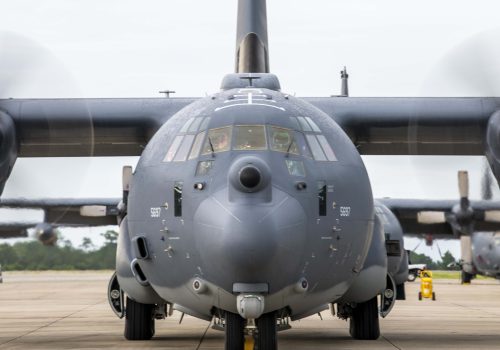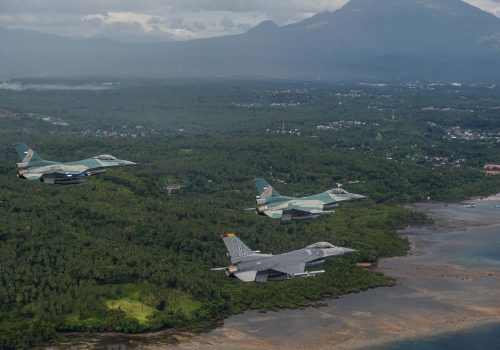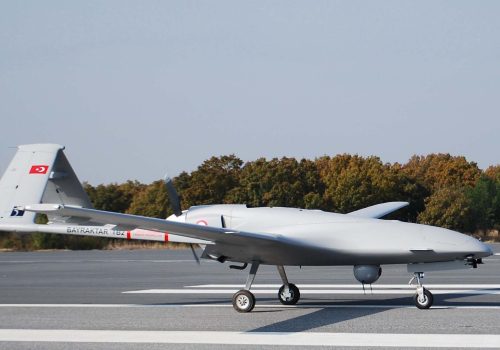Here’s what F-16s will (and will not) mean for Ukraine’s fight against Russia
After months of deliberation over supplying advanced fighter aircraft to Ukraine, Denmark and the Netherlands jointly agreed earlier this week to send Ukraine F-16 fighter jets after the United States signaled it would support the transfer. The timeline for Ukraine receiving these supersonic jets is predicated on Ukrainian pilots and ground crew completing training on the aircraft as well as the establishment of maintenance facilities to handle repairs, both of which do not appear likely in the near future. Additionally, the number of F-16s the Dutch and the Danes can send to Ukraine will depend on how many jets in their arsenals are in working order and how soon they receive F-35 joint strike fighters from the United States, which will enable them to retire their F-16s.
Following the news from Europe, the US Department of Defense on Thursday announced that it would begin a training program in Arizona in October. These efforts will build on those of European countries looking to help train Ukrainian pilots in Denmark and Romania. Estimates of how long the training will take vary from just over a month to more than a year, and the integration of F-16s into Ukraine’s fighting force will take time, but even after their delivery, a critical question remains: What do these jets mean for Ukraine’s efforts to defend itself against Russian aggression?
The delivery of F-16s will provide Ukraine with greatly increased capabilities in the air domain and may also have other indirect military and political benefits. However, the addition of these aircraft alone is unlikely to have a decisive strategic effect on the course of the conflict given the operational challenges Ukraine faces. Analysts such as Frank Hoffman and Maximillian Bremer and Kelly Grieco have discussed ways in which the war has challenged assumptions related to the offense-defense balance. Indeed, the war has raised important questions about the long-held belief that it is easier to establish air dominance rather than air denial. The Russians have learned this first-hand as the multi-layered air defense systems Ukraine now operates, including surface-to-air-missiles, have effectively denied air superiority to the Russian Air Force. In this context, where air defense is the name of the game, the operational impact of F-16s may be limited.
The benefits
The F-16s will help Ukrainian forces, since the jets will replace losses Ukraine has suffered over the course of the war. The Ukrainian Air Force entered the war with approximately seventy fighter aircraft split between older-generation Mig-39 and Su-27 jets. While Ukraine has received two dozen additional Mig-39s from Poland and Slovakia, it has lost at least thirty-two fighters based on visually confirmed evidence. These losses are partially due to the fact that Russia has so far enjoyed a decisive advantage in radar and air-to-air missile capabilities. Russian aircraft, such as the Su-35S and Mig-31BM, have advanced radar systems that can lock and fire on Ukrainian aircraft before the latter can detect them. Furthermore, these Russian aircraft employ active radar homing missiles, such as the R-77 and the ultra-long-range R-37M, which far outclass the semi-active R-27 carried by Ukrainian fighters. These factors mean that Ukrainian pilots have so far fought from a major disadvantage, with Russian aircraft being able to see Ukrainian jets first and shoot before they can respond.
The F-16s will be superior to Ukraine’s older jets. With their more powerful radars and better resistance to jamming, the F-16s will be able to detect Russian aircraft at longer distances and allow Ukrainian pilots to stay further outside the range of front-line Russian air defenses. Furthermore, these F-16s will likely be equipped with AIM-120 AMRAAMs, air-to-air missiles that have similar, and likely superior, performance compared to the Russian R-77.
Additionally, operating F-16s will provide Ukraine with a platform capable of easily integrating a wide variety of sophisticated weapon systems should the United States and other countries choose to provide them in the future. These could include the AN/ALQ-131, an electronic countermeasures pod meant to scramble enemy radar to avoid detection, or stand-off kinetic weapons like the Small Diameter Bomb and even cruise missiles such as the AGM-158 JASSM. Once Ukraine has the capability to operate F-16s, the door would potentially be open for NATO countries to provide these weapons, since they are easily compatible with the US-made fighter jet, unlike with the previously used Soviet aircraft.
Finally, the transfer of F-16s may provide an indirect benefit of freeing additional Ukrainian anti-air systems to defend against Russian drone and missile attacks. With the provision of more capable aircraft to cover its front-line troops from air attack, Ukraine may be able to allocate more ground-based air defenses to protect its civilian population and critical infrastructure from indiscriminate Russian missile strikes.
The limits
However, despite the range of advantages that the F-16s may have over the other aircraft Ukraine operates, expectations about their overall impact on the war must be tempered. The widespread presence of ground-based anti-air defenses has severely limited the ability of airpower to play a decisive role in supporting offensive maneuver on both sides of the conflict. Russia’s employment of the S-400 surface-to-air missile system is a major threat to all Ukrainian jets, including the F-16, as it can target aircraft at medium and high altitude across a large portion of the country even while based in Belarus, Crimea, or Russian territory. Ukrainian jets will still need to operate at low altitude, using the radar-cluttering effect of terrain to increase their survivability. This tactic, while sound, will continue to put Ukrainian F-16s at a disadvantage in engagements with Russian fighters. Russian jets operating at higher altitude can impart greater kinetic energy to the air-to-air missiles they launch, increasing the speed, range, and overall lethality of their weapons. In contrast, even F-16s must contend with the laws of physics if fighting from below, since their missiles will be slowed by gravity and denser air before they reach their targets.
Aside from the threat of enemy fighters and long-range S-400s, the proliferation of various types of short-range and man-portable air defenses across the battlefield will also pose a threat to Ukrainian F-16s operating in support of ground troops close to the front line. Finally, even when not in the air, Ukrainian F-16s will be vulnerable on the ground to Russian missile strikes, which have destroyed multiple Ukrainian aircraft in the past.
Despite the low prospects for F-16s to play a game-changing role in the conflict, the effort spent training Ukrainian pilots, ground crews, and logisticians to operate and maintain these aircraft will have long-term value. Given that this war may unfortunately continue for the foreseeable future, having a platform that can more easily accept Western weapon systems, software, and maintenance will provide opportunities for greater efficiency in military aid to Ukraine down the road.
In the long term, both NATO and Ukraine share the goal of the country joining the Alliance. Therefore, familiarizing the Ukrainian Air Force with NATO standards and training in sophisticated systems now will help set the stage for future interoperability.
Clementine G. Starling is the director of the Atlantic Council’s Forward Defense program and a resident fellow within the Scowcroft Center for Strategy and Security.
Jacob Mezey is a program assistant in the Forward Defense program.
Holly Ryan is a young global professional in the Forward Defense program.
Further reading
Tue, Aug 30, 2022
Ukraine air war examined: A glimpse at the future of air warfare
Airpower after Ukraine By Tyson Wetzel
Six months into the war in Ukraine, defense planners can learn from Ukrainian success and Russian failures in the air domain.
Tue, Aug 30, 2022
Air denial: The dangerous illusion of decisive air superiority
Airpower after Ukraine By
The air war in Ukraine challenges traditional paradigms of air superiority. US and allied air forces must instead contemplate air denial strategies.
Tue, Aug 30, 2022
The TB2: The value of a cheap and “good enough” drone
Airpower after Ukraine By
The Turkish Bayraktar TB2 is an effective, low-cost tactical weapon on the modern battlefield. While invaluable for all wars, it is not a game-changing technology.
Image: A Danish F-16 integrates with a U.S. B-52H Stratofortress, assigned to the 2nd Bomb Wing, Barksdale Air Force Base, Louisiana, out of Morón Air Base, Spain, in support of Bomber Task Force Europe June 07, 2021. (US Air Force photo by Tech. Sgt. Jael Laborn)


